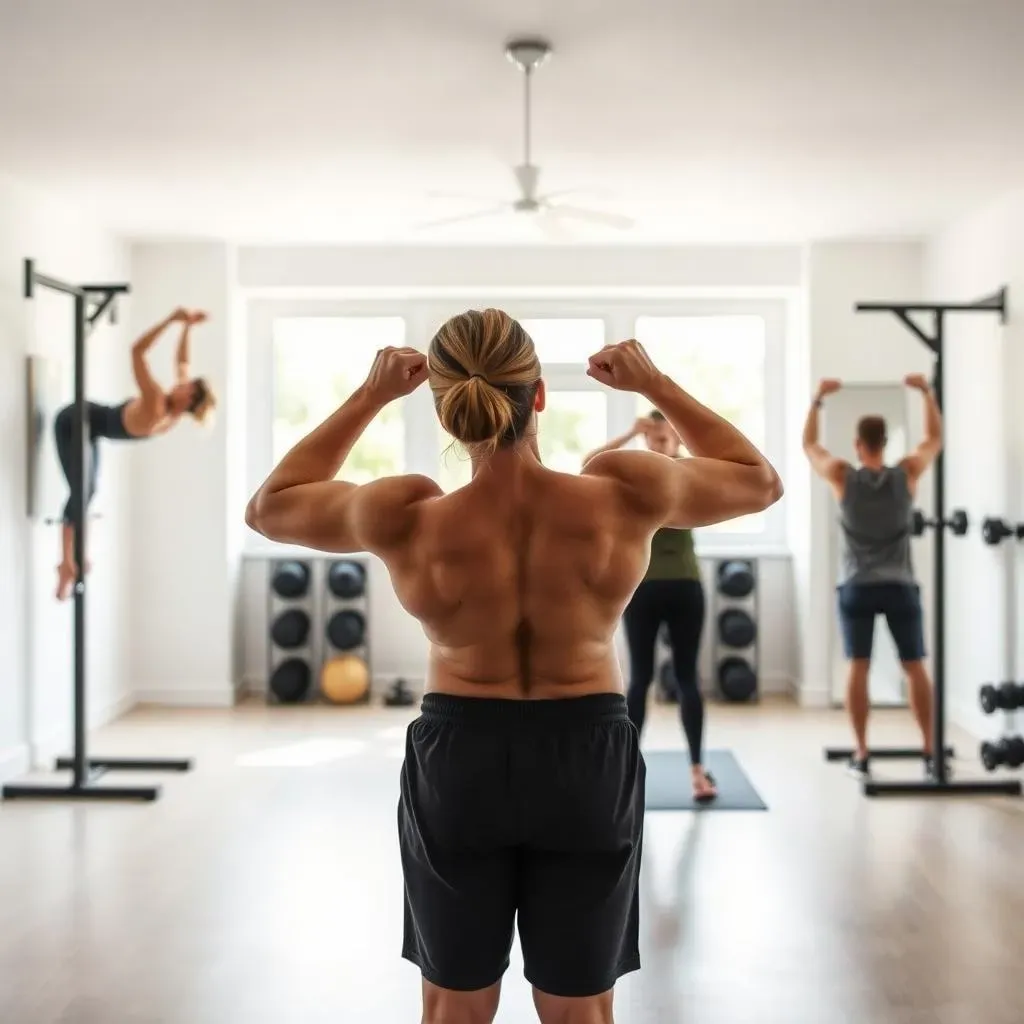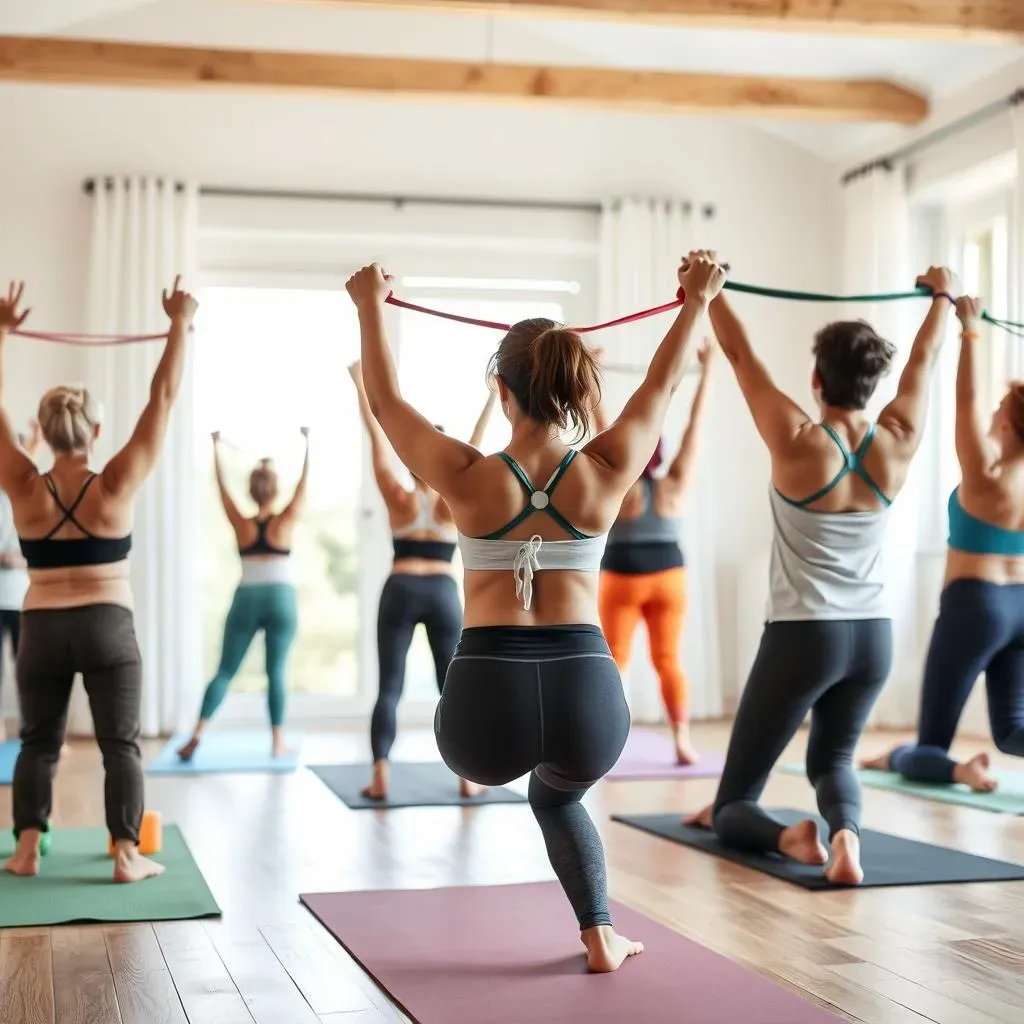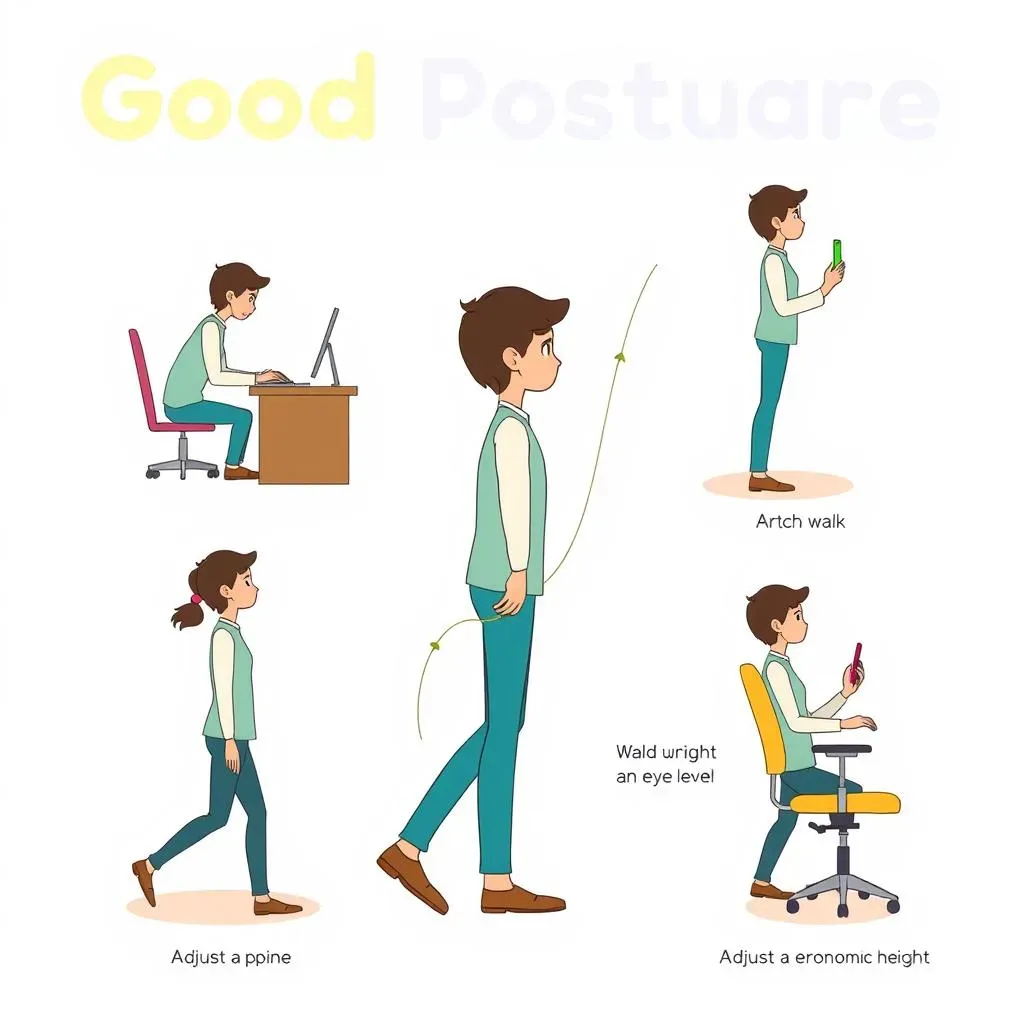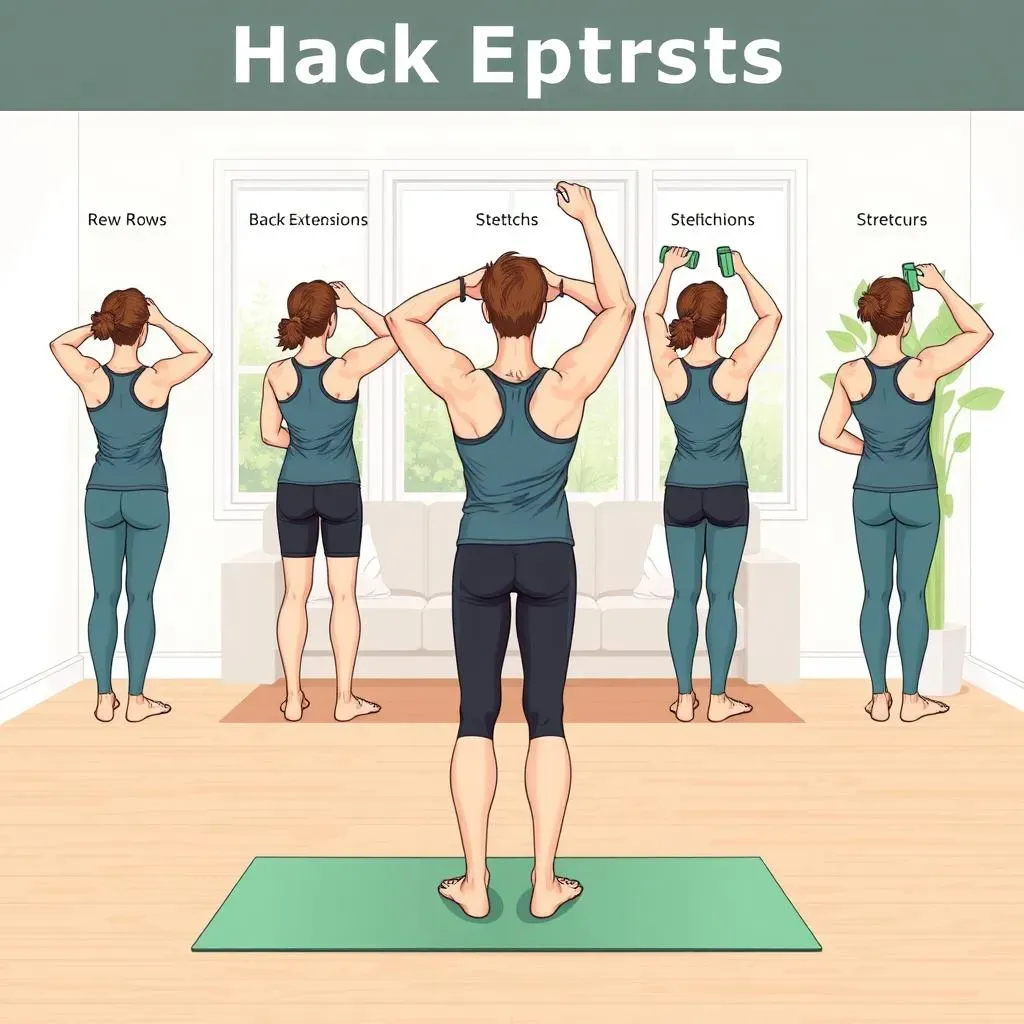Table of Contents
Ever feel like you're slowly turning into a question mark? You know, that hunched-over feeling that comes from too much sitting and not enough movement? Well, you're not alone! Many of us struggle with poor posture, which can lead to back pain, neck stiffness, and even make us look less confident. The good news is you don't need a fancy gym to fix it. We're talking about simple, yet effective, back workouts at home for posture. This article is your guide to understanding why posture matters, how specific exercises can help, and how to create a routine that fits your life. We'll explore the core exercises, how to make them part of your day, and, most importantly, how to maintain that upright position. Get ready to say goodbye to slouching and hello to a stronger, more confident you. Let's get started! We will be covering why back workouts at home are the key for better posture, essential exercises, how to create a routine and tips to maintain your posture.
Why Back Workouts at Home are Key for Better Posture

Why Back Workouts at Home are Key for Better Posture
The Posture Problem
Let's face it, we spend a lot of time hunched over. Whether it's staring at our phones, working at a desk, or even just relaxing on the couch, our backs often bear the brunt. This constant slouching weakens the muscles that support our spine, like a building with a bad foundation. When these muscles are weak, our posture suffers, leading to that rounded shoulder and forward head look that screams "I need a vacation...and a chiropractor." Doing back workouts at home helps you strengthen those neglected muscles, pulling your shoulders back and aligning your spine. It's like giving your back a much-needed hug and telling it, "I got you."
Think of your spine as a stack of building blocks. When the muscles around it are weak, the blocks start to wobble and lean. Now, imagine those blocks are your vertebrae, and the wobble is causing you pain. Strong back muscles act like the cement that holds everything together, keeping your spine straight and stable. That's why back workouts at home for posture are so important. They're not just about looking good; they're about building a strong, pain-free foundation for your body. Plus, who doesn't want to stand taller and feel more confident?
The Convenience Factor
The beauty of back workouts at home is that you don't need a gym membership or fancy equipment. You can do them anytime, anywhere. No more excuses about not having time or not wanting to go to the gym. Your living room can become your personal posture-improving playground! You can squeeze in a quick 15-minute session during a work break, or get a full workout in while watching your favorite show. The key is consistency, and doing it at home makes it much easier to stick to a routine. Plus, you can wear whatever you want—pajamas are totally acceptable workout attire in your own space!
It's not just about convenience, it is also about control. You choose your workout time, you pick the exercises that work for you, and you can go at your own pace. There's no pressure, no judgment, just you and your journey to a better back. This is especially great for beginners who might feel intimidated by a gym setting. Think of it as your personal back-strengthening sanctuary. So, ditch the gym commute and embrace the power of back workouts at home for posture. Your spine will thank you for it.
Benefit | Description |
|---|---|
Improved Posture | Strengthens muscles, aligns spine, reduces slouching. |
Convenience | Work out anytime, anywhere, no gym needed. |
Reduced Pain | Supports spine, alleviates back and neck discomfort. |
Increased Confidence | Standing taller can boost self-esteem. |
Control | Personalized workout, at your own pace. |
Essential Back Exercises at Home for Posture Correction

Essential Back Exercises at Home for Posture Correction
The "Super Six" for Posture
Alright, let's get to the good stuff – the exercises! Think of these as your "super six" for posture correction. These are not complicated moves that require a lot of space or equipment. We're talking about simple, effective exercises you can do right now in your living room. First up, we've got the classic cat-cow stretch. It is like a gentle dance for your spine, warming it up and improving mobility. Next, we have the bird dog, which might sound silly, but it's a powerhouse for core and back strength. It's like a plank, but with a bit more coordination and balance. Then, we have plank, the king of core exercises, and who doesn't want a strong core? It's the foundation for a good posture. Followed by superman, which helps to strengthen your lower back muscles. We can't forget about the wall slides, which are great for opening up your chest and shoulders. Last but not least, we have standing rows using resistance bands, which can be done anywhere. These are the fundamental building blocks for a better posture.
Now, these aren't just random moves. Each exercise targets specific muscles that play a crucial role in maintaining good posture. The cat-cow loosens your spine, the bird dog strengthens your core and back, the plank stabilizes your midsection, the superman hits those lower back muscles, the wall slides open up your chest and the rows strengthen your upper back. It’s like a well-orchestrated symphony, where each instrument (exercise) plays its part to create a beautiful melody (good posture). Remember, it's not about how many reps you can do, but how well you do them. Focus on proper form and controlled movements. You'll get stronger and more flexible over time. So, let’s get moving! You've got this!
Form Over Everything
Before you jump into these exercises, let's talk about form. It's not about speed or how many you can do; it's about doing them correctly. Think of it like learning a new dance move. You wouldn't just flail around, right? You'd focus on each step, making sure you're doing it right. The same goes for these exercises. If you're doing them incorrectly, you might not be getting the full benefit, or worse, you could end up hurting yourself. For the cat-cow, focus on the gentle arch and round of your back, not just the up and down motion. With the bird dog, imagine balancing a glass of water on your lower back, keep it steady. For the plank, keep your body in a straight line, from head to heels. And for the wall slides, make sure your back and arms are pressed against the wall. Remember, quality over quantity is the name of the game. Don't rush; focus on feeling the muscles engage.
Listen to your body, it's your best coach. If something feels painful, stop. You can always modify the exercise to fit your current fitness level. For example, if a full plank is too challenging, start with a modified plank on your knees. If you need to, start slow, focus on the form and increase the reps and set as you progress. The goal isn't to push yourself to the point of exhaustion but to build a consistent, sustainable routine. These moves are just the start of your journey to better posture and a stronger back. So, take your time, be patient, and enjoy the process. Remember, every rep you do is a step closer to a straighter spine and a more confident you!
Exercise | Target Muscles | How it helps posture |
|---|---|---|
Cat-Cow Stretch | Spine, core | Improves spine mobility |
Bird Dog | Core, back | Strengthens core and back |
Plank | Core | Stabilizes midsection |
Superman | Lower back | Strengthens lower back muscles |
Wall Slides | Chest, shoulders | Opens up chest and shoulders |
Standing Rows | Upper back | Strengthens upper back |
Creating Your Back Workout Routine at Home for Posture

Creating Your Back Workout Routine at Home for Posture
Start Simple, Stay Consistent
Okay, so you've got your "super six" exercises down. Now, how do you turn them into a routine? It's not about spending hours every day; it's about being consistent. Think of it like brushing your teeth – you don't do it once a month; you do it every day. Start with 15-20 minutes, 3-4 times a week. You can break it up into smaller chunks if you have a busy schedule. Maybe 5 minutes in the morning, 5 minutes at lunch, and 5 minutes before bed. The key is to find something that works for you. Don't feel like you need to do everything perfectly right away. Start with 2 sets of 8-10 repetitions of each exercise, and gradually increase the sets and reps as you get stronger. It's a marathon, not a sprint, so be patient with yourself and enjoy the process. Remember, small steps lead to big results.
It’s also important to listen to your body. If you’re feeling tired, take a rest day. Don't push yourself too hard, especially when you're just starting out. Remember, this is a journey, and every step counts. Some days you might feel like you can do more, and other days you might need to scale back. That’s perfectly normal. The important thing is to keep showing up and do what you can on that day. You're building a habit, not just a workout, and consistency is key. So, find a time that works for you, set a reminder, and make it a non-negotiable part of your day. Your back will thank you for it.
Mix it Up and Make it Fun
Doing the same exercises every time can get a little boring, right? It's like eating the same meal every day – eventually, you'll crave something different. So, don't be afraid to mix things up! There are so many variations of these exercises that you can try. For example, instead of a regular plank, try a forearm plank or a side plank. Or, if you're feeling adventurous, add a twist to your bird dog by bringing your elbow to your knee. You can also incorporate other bodyweight exercises that target your back, like push-ups, or rows with a towel. The possibilities are endless! The key is to keep challenging yourself and keep things interesting. This will not only prevent boredom but also help you target different muscles and improve your overall strength and flexibility.
You can also make your workouts more fun by adding some music or watching a show while you exercise. Or, better yet, do it with a friend or family member! Having someone to work out with can make it more enjoyable and keep you accountable. It's like having a workout buddy who's as excited about your posture journey as you are. It’s also good to track your progress. Keep a journal of your workouts, noting how many reps and sets you did, and how you felt afterwards. This can be a great way to stay motivated and see how far you’ve come. Remember, your workouts should be something you look forward to, not something you dread. So, experiment, have fun, and find what works best for you. This is your journey, so make it enjoyable!
Routine Element | Description |
|---|---|
Frequency | 3-4 times a week |
Duration | 15-20 minutes per session |
Sets/Reps | Start with 2 sets of 8-10 reps, increase gradually |
Variations | Mix up exercises to prevent boredom and target different muscles |
Fun Factor | Add music, workout buddies, track progress |
Listen to Your Body
This is the golden rule of any workout routine: listen to your body! If you’re feeling pain, stop. It's not about pushing through the pain; it's about respecting your body's limits. Some days you might feel like a superhero, and other days you might feel like you need to take it easy. That's perfectly okay. Adjust your routine based on how you're feeling. If you're feeling tired, take a rest day. If you're feeling extra energetic, go ahead and add a few extra reps or sets. The key is to be flexible and adapt to your body's needs. Remember, consistency is important, but it's not worth pushing yourself to the point of injury. Your health is your priority.
Also, pay attention to how you feel after your workouts. If you're feeling sore, that's normal. But if you're feeling sharp or persistent pain, that's a sign that you need to take a break or adjust your routine. You can also consult with a doctor or physical therapist if you have any concerns. They can help you create a personalized plan that’s safe and effective for you. Remember, your body is your best guide, and it’s important to listen to it. So, be kind to yourself, be patient, and enjoy the process of building a stronger, healthier back.
Tips to Maintain Good Posture After Your Back Workouts at Home

Tips to Maintain Good Posture After Your Back Workouts at Home
The Posture-Aware Life
Okay, so you’ve crushed your back workout at home; that’s fantastic! But here’s the thing: good posture isn’t just about those 20 minutes of exercise. It’s about how you carry yourself the rest of the day. It’s like building a house, you can't just build the foundation and expect it to stand, you have to make sure the walls are straight and the roof is strong. Think of your daily routine as a series of opportunities to practice good posture. When you’re sitting at your desk, make sure your feet are flat on the floor and your back is supported. When you’re walking, imagine a string pulling you up from the top of your head. When you are looking at your phone, bring it up to eye level, instead of looking down. It's about being mindful of your body's position, no matter what you're doing. It’s like becoming a posture detective, always on the lookout for those sneaky slouching habits. And trust me, they're everywhere!
This is about making small, consistent changes that add up to big results. It's about creating a lifestyle where good posture is the norm, not the exception. It’s not just about remembering to sit up straight, it's about creating an environment that supports good posture. So, check your chair, make sure your desk is at the right height and that your phone is on eye level. It’s about being proactive, not reactive. It's about making choices that support your back, not work against it. It's like creating a positive feedback loop, where good posture leads to more good posture. And the best part? It’s all within your control. You've already taken the first step by starting your back workouts; now it’s time to make good posture your everyday habit. You've got this!
Tip | Description |
|---|---|
Mindful Sitting | Feet flat, back supported, avoid slouching |
Upright Walking | Imagine a string pulling you up from the head. |
Phone at Eye Level | Avoid looking down, bring the phone to your eyes. |
Ergonomic Setup | Adjust desk and chair height, create a good environment |
Proactive Choices | Make choices that support good posture, not work against it. |
Little Tricks, Big Impact
Okay, let's talk about some simple tricks you can use throughout the day to maintain that good posture. First up, let’s talk about the wall test. Stand with your back against a wall, making sure your head, shoulders, and butt are all touching it. This is the posture you're aiming for. Now, step away from the wall, and try to maintain that same feeling. It's like your body is taking a snapshot of good posture. Another trick is to set reminders on your phone. A little buzz every hour can be a gentle nudge to check your posture, it’s like a friendly reminder from your own personal posture coach. And let’s not forget about stretching. A few simple stretches throughout the day can help release tension and improve flexibility. It’s like giving your back a little mini-vacation, a chance to unwind and reset.
These little tricks may seem small, but they can make a big difference over time. Think of it like planting seeds. Each little trick is a seed you're planting, and with time and care, they'll grow into a beautiful garden of good posture. It's not about perfection; it's about progress. It’s about being mindful of your body and taking small steps towards a healthier, more aligned you. And remember, you're not alone in this journey. We all struggle with posture from time to time. The key is to be patient, persistent, and kind to yourself. So, embrace these little tricks, make them part of your daily routine, and watch as your posture improves, not just during your workouts, but throughout your entire day. You've got this!
